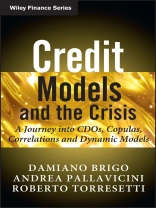The recent financial crisis has highlighted the need for better
valuation models and risk management procedures, better
understanding of structured products, and has called into question
the actions of many financial institutions. It has become
commonplace to blame the inadequacy of credit risk models, claiming
that the crisis was due to sophisticated and obscure products being
traded, but practitioners have for a long time been aware of the
dangers and limitations of credit models. It would seem that a lack
of understanding of these models is the root cause of their
failures but until now little analysis had been published on the
subject and, when published, it had gained very limited attention.
Credit Models and the Crisis is a succinct but technical
analysis of the key aspects of the credit derivatives modeling
problems, tracing the development (and flaws) of new quantitative
methods for credit derivatives and CDOs up to and through the
credit crisis. Responding to the immediate need for clarity in the
market and academic research environments, this book follows the
development of credit derivatives and CDOs at a technical level,
analyzing the impact, strengths and weaknesses of methods ranging
from the introduction of the Gaussian Copula model and the related
implied correlations to the introduction of arbitrage-free dynamic
loss models capable of calibrating all the tranches for all the
maturities at the same time. It also illustrates the implied
copula, a method that can consistently account for CDOs with
different attachment and detachment points but not for different
maturities, and explains why the Gaussian Copula model is still
used in its base correlation formulation.
The book reports both alarming pre-crisis research and market
examples, as well as commentary through history, using data up to
the end of 2009, making it an important addition to modern
derivatives literature. With banks and regulators struggling to
fully analyze at a technical level, many of the flaws in modern
financial models, it will be indispensable for quantitative
practitioners and academics who want to develop stable and
functional models in the future.
Daftar Isi
Preface.
Acknowledgements.
About the Authors.
Notation and List of Symbols.
1 Introduction: Credit Modelling Pre- and In-Crisis.
1.1 Bottom-up models.
1.2 Compound correlation.
1.3 Base correlation.
1.4 Implied Copula.
1.5 Expected Tranche Loss Surface.
1.6 Top (down) framework.
1.7 GPL and GPCL models.
1.8 Structure of the book.
2 Market Quotes.
2.1 Credit indices.
2.2 CDO tranches.
3 Gaussian Copula Model and Implied Correlation.
3.1 One-factor Gaussian Copula model.
3.1.1 Finite pool homogeneous one-factor Gaussian Copula
model.
3.1.2 Finite pool heterogeneous one-factor Gaussian Copula
model.
3.1.3 Large pool homogeneous one-factor Gaussian Copula
model.
3.2 Double-t Copula Model.
3.3 Compound correlation and base correlation.
3.4 Existence and non-monotonicity of market spread as a
function of compound correlation.
3.5 Invertibility limitations of compound correlation:
pre-crisis.
3.6 Base correlation.
3.7 Is base correlation a solution to the problems of compound
correlation?
3.8 Can the Double-t Copula flatten the Gaussian base
correlation skew?
3.9 Summary on implied correlation.
4 Consistency across Capital Structure: Implied
Copula.
4.1 Calibration of Implied Copula.
4.2 Two-stage regularization.
4.3 Summary of considerations around Implied Copula.
5 Consistency across Capital Structure and Maturities:
Expected Tranche Loss.
5.1 Index and tranche NPV as a function of ETL.
5.2 Numerical results.
5.3 Summary on Expected (Equity) Tranche Loss.
6 A Fully Consistent Dynamical Model: Generalized-Poisson
Loss Model.
6.1 Loss dynamics.
6.2 Model limits.
6.3 Model calibration.
6.4 Detailed calibration procedure.
6.5 Calibration results.
7 Application to More Recent Data and the Crisis.
7.1 Compound correlation in-crisis.
7.2 Base correlation in-crisis.
7.3 Implied Copula in-crisis.
7.4 Expected Tranche Loss surface in-crisis.
7.4.1 Deterministic piecewise constant recovery rates.
7.5 Generalized-Poisson Loss model in-crisis.
8 Final Discussion and Conclusions.
8.1 There are more things in heaven and earth, Horatio. . .
.
8.2 . . . Than are dreamt of in your philosophy.
Bibliography.
Index.
Tentang Penulis
DAMIANO BRIGO is Managing Director and Global Head of the Quantitative team at Fitch Solutions, and Visiting Professor at the Department of Mathematics at Imperial College, London.
Damiano has published more than 50 articles in top journals for mathematical finance, systems theory, probability and statistics, and a book for Springer Verlag that has become a field reference in stochastic interest rate modelling. He is Managing Editor of the International Journal of Theoretical and Applied Finance, he is a member of the Fitch Academic Advisory Board and is part of scientific committees for academic conference occurring at MIT and other academic and industry institutions. Damiano has also been a charter member of Risk’s Who’s Who since 2007.
Damiano’s interests include pricing, risk measurement, credit and default modelling, counterparty risk, and stochastic dynamical models for commodities and inflation.
Damiano obtained a Ph.D. in stochastic filtering with differential geometry in 1996 from the Free University of Amsterdam, following a BSc in Mathematics with honours from the University of Padua.
ANDREA PALLAVICINI is Head of Financial Engineering at Banca Leonardo in Milan. Previously, he worked as Head of Equity and Hybrid Models in Banca IMI, working also on dynamical loss models, interest-rate derivatives, smile modelling and counterparty risk.
Over the years he has published several academic and practitioner-oriented articles in financial modelling, theoretical physics and astrophysics. He has taught Master courses in finance at the Universities of Pavia and Milan.
He obtained a Degree in astrophysics, and a Ph.D. in theoretical and mathematical physics from the University of Pavia.
ROBERTO TORRESETTI is responsible for Structured Credit Derivatives at BBVA. He was previously a senior credit derivatives modeller at Banca IMI and equity derivatives analyst at Lehman Brothers and a quantitative fund manager at San Paolo IMI Asset Management. He holds a bachelor’s degree in economics from Università Bocconi in Milan and completed his MA in economics at Università Bocconi and MS in financial mathematics at the University of Chicago.












